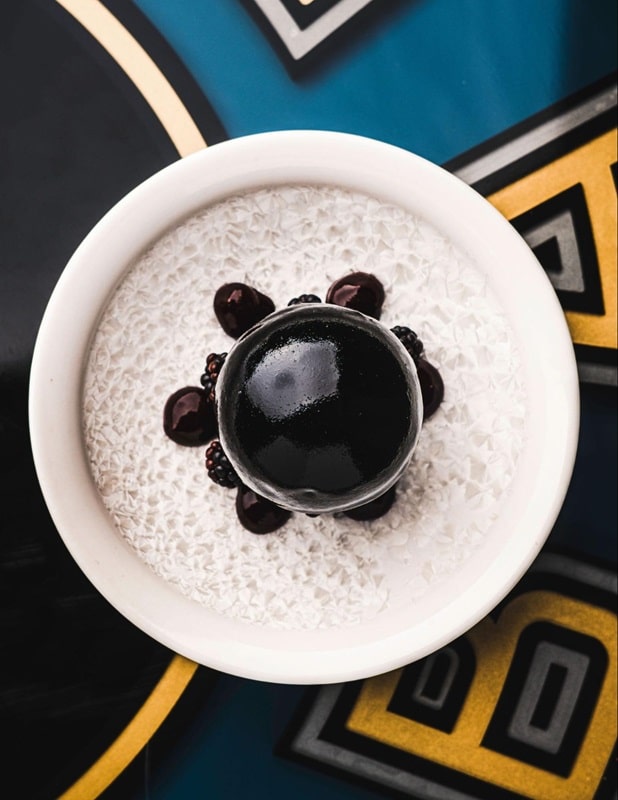Seafood 101:
The Process of Caviar Production
Often associated with luxury and decadence, caviar has captivated food enthusiasts for centuries. From its origins in ancient Persia to the modern-day delicacy it has become, we will explore every step of the caviar production process. Join us as we navigate the intricate methods of harvesting roe from sturgeon, processing them into this exquisite culinary delight, and finally savoring the unique flavors each caviar variety offers.
What is the process of making caviar?
Making caviar typically involves several steps, although it may vary slightly depending on the type of caviar being produced. Here is a general outline of the process:

Experience seafood and more on the Vegas Strip by booking a reservation today.
- Caviar harvesting: Caviar is obtained from various species of sturgeon or fish, such as Beluga, Osetra, and Sevruga. The fish are carefully caught or farmed in pristine conditions to ensure caviar harvesting provides high-quality eggs.
- Extracting the roe: Once the sturgeons are caught, their eggs (roe) are removed intact without damaging them. This delicate step requires expertise to prevent any contamination.
- Separating membranes and impurities: The collected roe is gently placed into a fine mesh sieve to separate any connective tissues or debris from the eggs
- Washing: The separated eggs undergo gentle washing with cold water to remove natural oils and excess salt
- Salting (curing): After washing, the roe is layered in a container and covered with salt for curing purposes. Curing time depends on personal preference and ranges from a few minutes to an hour.
- Rinsing off salt: Following curing, excess salt gets rinsed off using filtered water multiple times until the desired saltiness level is achieved for that particular type of caviar
- Draining excess moisture: Once rinsed thoroughly, drained caviar allows extra moisture to escape through small holes left by separators, allowing enhanced texture development during the aging process
- Aging process: Some types of caviar benefit from aging, where they’re stored in refrigerated rooms at specific temperatures for weeks or months under controlled atmospheric conditions, further enhancing flavor complexity before packaging
- Caviar packaging: After the desired curing and aging process, caviar is carefully packed into small jars or tins. The caviar packaging containers are sealed to maintain freshness and prevent any oxidation.
- Quality control: Before heading out for distribution, caviar undergoes rigorous quality control checks to ensure the eggs meet the specific caviar grade standards for size, color, texture, flavor profile, and absence of impurities
Storage and transportation: Caviar is typically stored in chilled conditions at temperatures around 32-39°F (0-4°C) to maintain its freshness during shipping and storage
How is caviar traditionally made?
The traditional method of making caviar involves catching the sturgeon and then stunning the fish. The ovaries are then extracted from the fish. However, this process resulted in killing the fish. So, it was replaced with modern farming techniques where the fish is sedated, the eggs removed, and the fish released back into the aquafarm to make more eggs.
How long does it take to farm caviar?
The time it takes to farm caviar varies depending on several factors, including the species of sturgeon or fish and the desired quality. Generally, it can take anywhere from five to twenty years for a sturgeon to reach maturity and produce eggs suitable for caviar production.
The growth rate of farmed sturgeons depends on various factors such as water temperature, diet, genetics, and farming practices. In optimal conditions with proper nutrition and care, some sturgeons may start producing eggs as early as five to seven years old.
However, for high-quality caviar like Beluga or Osetra that command premium prices in the market due to their large size and delicate flavor, it often takes at least ten to fifteen years before they mature enough for their first harvest.
How is caviar sourced?
Caviar is sourced through various methods, depending on whether it is wild-caught or farmed.
Wild-caught caviar:
- Fishing: Historically, caviar was primarily obtained by fishing for sturgeons and other fish species in their natural habitats, such as rivers, lakes, or seas. Skilled fishermen would capture the fish using nets or hooks and carefully extract the roe from harvested individuals.
- Regulation: Many countries have implemented strict regulations to protect wild sturgeons due to overfishing concerns and declining sturgeon populations in the past century. Legal harvesting of wild-caught caviar now often involves permits and quotas issued by authorities to control and monitor fishing activities.
Caviar farming:
- Aquaculture farms: Today, a significant portion of caviar comes from aquaculture farms where sturgeons are bred in controlled environments specifically designed for their growth and well-being and sustainable caviar production
- Artificial insemination: Artificial insemination techniques have been developed to produce roe for farming purposes without harming wild populations. This involves collecting eggs from female sturgeons and combining them with sperm collected from male sturgeons to fertilize the eggs outside their natural habitat.
- Controlled conditions: In caviar farming, water quality parameters, temperature, salinity, and feed composition, often consisting of high-protein pellets, size-controlled tanks, and monitoring systems, are maintained to ensure optimal growth conditions throughout the process
Where can I get the best caviar in Las Vegas?

Looking for the best caviar in Las Vegas? Look no further than Aqua Seafood & Caviar restaurant, conveniently located on the Vegas Strip. Indulge in the finest selection of seafood and premium caviar, meticulously sourced and expertly prepared. Whether you are a beginner or a caviar expert, experience luxury indulgence like never before by visiting us today.
Come join us for dinner by booking your dining reservation online now.
